1507 A decolonization manifesto
Unsettling Canada: A National Wake-up Call, Second Edition
by Arthur Manuel and Ronald M. Derrickson, with a foreword by Naomi Klein
Toronto: Between the Lines, 2021 (first published 2016)
$29.95 / 9781771135566
Reviewed by Ken Favrholdt
*
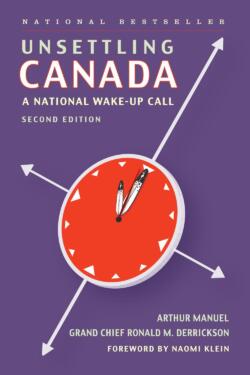 Unsettling Canada: A National Wake-up Call has been called a roadmap to action for Indigenous peoples in Canada by activist Naomi Klein who wrote the Foreword to the second edition. Written by the late Arthur Manuel of Neskonlith and Grand Chief Ronald Derrickson of the Westbank First Nation (opposite Kelowna), the book is part history, part biography, and part political polemic. Manuel’s chronological approach in this 17-chapter book works well in telling his story – his people’s story – a clear message about the “battle for our lands and our right to self-determination.”
Unsettling Canada: A National Wake-up Call has been called a roadmap to action for Indigenous peoples in Canada by activist Naomi Klein who wrote the Foreword to the second edition. Written by the late Arthur Manuel of Neskonlith and Grand Chief Ronald Derrickson of the Westbank First Nation (opposite Kelowna), the book is part history, part biography, and part political polemic. Manuel’s chronological approach in this 17-chapter book works well in telling his story – his people’s story – a clear message about the “battle for our lands and our right to self-determination.”
Arthur Manuel was born in 1951 in Neskonlith, a Secwépemc reserve east of Kamloops. Manuel was a teenager when he attended the Kamloops Indian Residential School, St. Mary’s in Mission, and St. Eugene’s in Cranbrook, where his Ktunaxa mother came from, but says he did not suffer abuse like many students. Art called himself both lucky and unlucky to grow up in a family that was devoted to the struggle of their people. He would follow in the footsteps of his father George Manuel, later national chief of the National Indian Brotherhood and founder of the World Council of Indigenous Peoples. George Manuel had worked as a boom man on a logging show on the South Thompson River and gradually entered the political realm, becoming a community development officer in Cowichan on Vancouver Island.

The White Paper of 1969, under Jean Chretien and Pierre Trudeau, which intended to dismantle Canada’s treaties with Indian nations and destroy Aboriginal title and rights is where Arthur Manuel says the modern struggle of Indigenous rights begins. The White Paper proposed abolishing the Indian Act and turning First Nations people into another ethnic group. All federal programs would be terminated and Indigenous reserve land be reduced to “fee simple” ownership.
The resistance that followed caught the government by surprise. In 1969 Arthur’s father and Philip Paul from the Tsartlip Band on Vancouver Island organized a meeting in Kamloops to formally launch the Union of BC Indian Chiefs with a mandate to fight the White Paper.
Arthur’s involvement in activism really began in Alberta in 1970 with the battle over First Nations control of Indian education. A strike, supported by Harold Cardinal and the Indian Association of Alberta, lasted until 1972. The government’s plan was to bus all students to off-reserve schools. As it happened, schools run by Indian bands were funded less than their non-reserve counterparts.

Arthur joined the Native Youth Association, became president, and planned in August 1973 to take over the Department of Indian Affairs building in Ottawa for 24 hours – “to confront unjust government policies towards our peoples…” The occupation ended peacefully but funding for the youth movement dried up. Manuel goes on to discuss the Calder Case in the Supreme Court in 1973 that recognized Aboriginal title.
By 1974 he married and had five children with Beverly Dick. “I decided the best way to take care of my family and continue the struggle for my people was to go to law school. I was part of a small wave of young activists of my generation who saw the law as a promising avenue for the struggle to have our rights respected. I think the Supreme Court’s Calder decision had something to do with that” (p. 55). But he left before completing his degree at York University in Toronto.
In 1980 a momentous event took place known as the Constitution Express where two trains with a thousand protestors left Vancouver for Ottawa to demand that recognition of Aboriginal title and treaty rights be written into the Constitution that Pierre Trudeau would repatriate in 1982. When the Constitutional Committee presented its report, an affirmation of Aboriginal title and rights was included in Section 35.
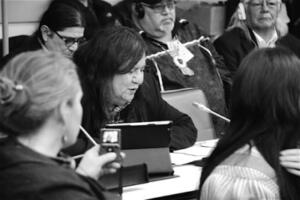
Manuel early took on the role of an advocate for Indigenous justice. At the United Nations he served as the co-chair for the Global Indigenous Peoples Caucus. There he condemned the “Doctrine of Discovery” by which Europeans claimed the lands of the Americas.
Later chapters in the book focus on more local events, such as Manuel’s decision to establish a gas station on the Neskonlith Reserve, and what it is like to be a chief. Manuel was chief of the Neskonlith band for four terms from 1995 to 2003. He describes the violent standoff over logging a sacred site in the Cariboo at Gustafsen Lake in Neskonlith territory, exercising Aboriginal title and rights, and demands that forestry companies seek Indigenous logging permits.

During the nineties Manuel was also elected chair (1993 to 2003) of the Shuswap Nation Tribal Council, “an organization that … co-ordinates the political and economic positions of the Secwépemc people.” He also worked to reconstitute the Interior Alliance comprising forty-five bands from five nations based on the former Allied Tribes of BC.
Manuel also obtained important positions and audiences on the world stage, part of the larger struggle that would gain impetus in his latter years. He travelled to Washington, New York, and Geneva to take on the softwood lumber battle at the World Trade Organization. He met his future spouse, an Austrian lawyer names Nicole Schabus, who specialized in international law, when he started the Indigenous Network on Economies and Trade (INET). He successfully got the ear of financial institutions like Standard and Poor’s on the subject of Aboriginal title and rights.
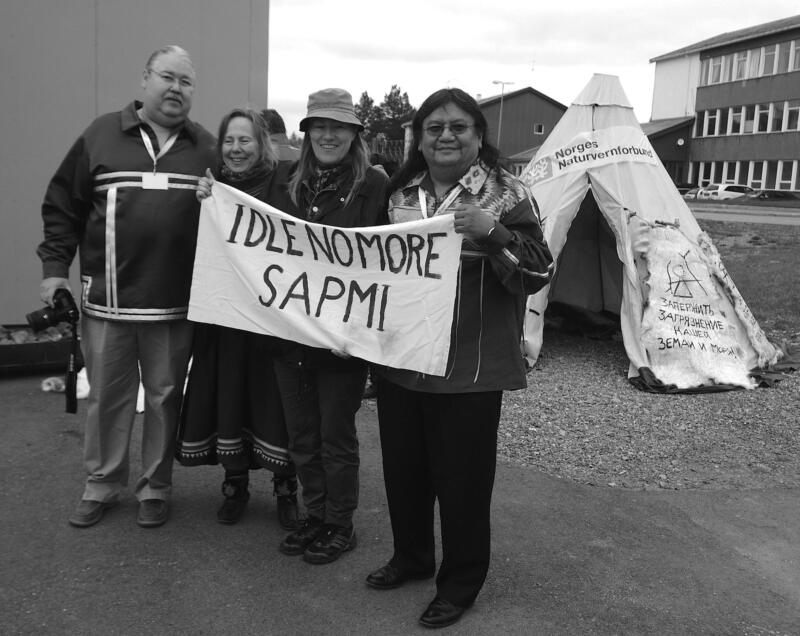
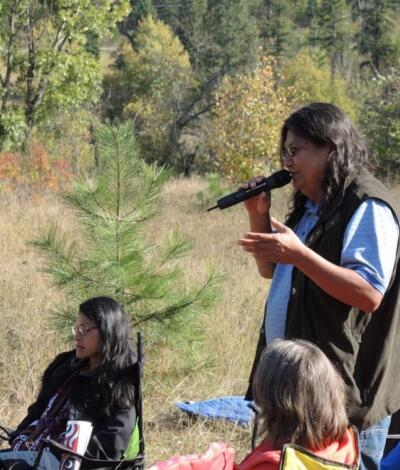
Then followed the proposal by Nippon Cable to expand Sun Peaks, the former Tod Mountain ski hill, into a multi-million dollar resort. The development was on the hunting and gathering grounds of Neskonlit band’s traditional territory. Direct action was taken by a group of Elders and youth in 2001, which Manuel says “fit with the strategy of proving our title on the ground.” But the protests at the Skwelkwek’welt Protection Centre and McGillivray Lake were unsuccessful and resulted in police action with arrests and the native camps being destroyed. The protests continued through 2002 with Elders and youth, including two of his daughters who returned to the camps after each eviction. There was a rising backlash from the non-Indigenous settler population; I recall being chastised as a freelance writer when I dared to mention the protest in a local magazine. But there was dissension in First Nations ranks as well. Criticized for the time he spent away from the reserve, Manuel did not win the band election in 2003. After this, Manuel and Nicole Schabus, who taught law at Thompson Rivers University in Kamloops, became a couple.

Manuel was elected co-chair of the Global Indigenous Peoples Caucus in 2002 and given the honour to address the Forum on the doctrine of discovery. The Forum demanded that the doctrine, which had never been revoked, be condemned as a crime against humanity.
A closing chapter in Unsettling Canada deals with environmental issues. “In the struggle to protect the land, Indigenous peoples are the first and last line of defence, but fortunately, we are not fighting these battles alone,” Manuel explains. “By the time of the 1992 UN Earth Summit in Rio de Janeiro, Indigenous representatives from around the world were present in large numbers to sound the alarm to the international community.” Manuel attended world-wide conferences on biodiversity over the next several years.
The Treaty process, promoted as the solution to the BC “land question,” as Manuel describes it, is flawed. In order to be removed from the process, as exemplified by the Xaxli’p (formerly known as the Fountain Band), a band must repay the loan it used to hire lawyers and researchers – resulting in the prospect of bankruptcy. Treaties end in extinguishment to Aboriginal titles and rights. “Plan B”, Manuel proposes, is that “we respect our territorial integrity and our internationally recognized right to self-determination and proprietorship of our lands.”
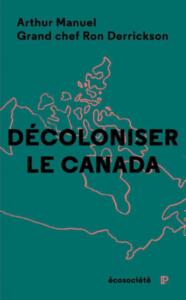
Two grassroots groups, the Idle No More movement and the Defenders of the Land, joined forces and made several demands of Canada, including to cease the policy of extinguishment of Aboriginal title; to honour the spirit and intent of historic treaties; to repudiate the racist “doctrine of discovery” and terra nullius; and to actively resist violence against women.
Manuel concludes Unsettling Canada with a chapter entitled “The End of Colonialism” and an important allusion to the land. “The recognition of Aboriginal title on the ground is a fundamental decolonizing action,” Manuel states. The Tsilhqot’in decision of 2014 is the first case in Canada where Indigenous peoples have repossessed their lost— or more accurately, stolen — inheritance.
Arthur passed away at the age of 65 in 2017 at the height of his work and the implementation of Plan B. The book contains two afterwords, one written by Grand Chief Ron Derrickson before Manuel’s untimely death, the second contributed after his death by his daughter Kanahus Manuel and wife Nicole Schabus. Derrickson poses an important question, “So what will be on the table in any true nation-to-nation negotiations between Canada and indigenous nations? Everything except the surrender of the land” (my emphasis).

Unsettling Canada ends, appropriately, with the United Nations Declaration on the Rights of Indigenous Peoples (UNDRIP) although Kanahus Manual and Nicole Shabus, activists in their own right, state in their afterword that “the current provincial and federal UNDRIP bills are at best window dressing and are really frameworks for the further domestication of Indigenous rights.” Kanahus writes:
If you go through it you will see that Canada is in flagrant violation of virtually all the core provisions regarding Indigenous self-determination, Indigenous land rights, and the requirements of governments to acquire Indigenous people’s free, prior and informed consent before initiating any developments on their land or/ and legislative and policy changes that affect us (p. 175).
Not well-known is that Canada initially voted against UNDRIP until, in 2009, it grudgingly followed the path taken by 144 nations. It was then fully endorsed by Canada in 2016.
Unsettling Canada, a national bestseller, won the Canadian Historical Association Aboriginal History Book Prize in 2016. It is well-written, readable, and one of the most important books to date on the struggle for self-determination and land rights of First Nations in Canada. It is an essential reference for anyone seeking to understand the history of this struggle from the Doctrine of Discovery in 1494 through colonization and to the present day. Unsettling Canada is indeed a national wake-up call and an eye-opener into the ongoing challenges of justice for Indigenous peoples in Canada.
*

Ken Favrholdt is a freelance writer, historical geographer and museologist with a BA and MA (Geography, UBC), a teaching certificate (SFU), and certificates as a museum curator. He spent ten years at the Kamloops Museum & Archives, five at the Secwépemc Museum and Heritage Park, four at the Osoyoos Museum, and he is now Archivist of Tk’emlúps te Secwépemc. He has written extensively on local history in Kamloops This Week, the former Kamloops Daily News, the Claresholm Local Press, and other community papers. Ken has also written book reviews for BC Studies and articles for BC History, Canadian Cowboy Country Magazine, Cartgraphica, Cartouche, and MUSE (magazine of the Canadian Museums Association). He taught geography courses at Thompson Rivers University and edited the Canadian Encyclopedia, geography textbooks, and a commemorative history for the Town of Oliver and Osoyoos Indian Band. Ken has undertaken research for several Interior First Nations and is now working on books on the fur trade of Kamloops and the gold-rush journal of John Clapperton, a Nicola Valley pioneer and Caribooite. He lives in Kamloops. Editor’s note: Ken Favrholdt has also reviewed books by Clarence Louie, John Macdonald, and Brett McGillivray for The British Columbia Review.
*
The British Columbia Review
Publisher and Editor: Richard Mackie
Formerly The Ormsby Review, The British Columbia Review is an on-line journal service for BC writers and readers. The Advisory Board consists of Jean Barman, Wade Davis, Robin Fisher, Cole Harris, Hugh Johnston, Kathy Mezei, Patricia Roy, Maria Tippett, and Graeme Wynn. Provincial Government Patron (since September 2018): Creative BC. Honorary Patron: Yosef Wosk. Scholarly Patron: SFU Graduate Liberal Studies.
“Only connect.” – E.M. Forster
5 comments on “1507 A decolonization manifesto”